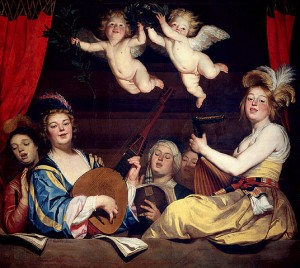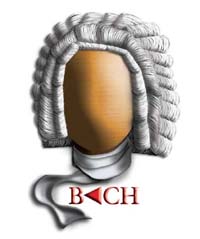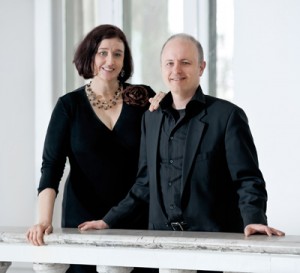
Het Concert, 1624. Gerrit von Honthorst
by Anne Schuster Hunter
When don’t Bach’s organ trio sonatas include organs? In Tempesta di Mare’s upcoming show, Bach Trio Sonatas. In it, Tempesta is playing what are in fact Bach’s six organ sonatas, but don’t expect organs. You might as well look for the ducks in duct tape.
In Tempesta’s version, you’ll get recorder, flute, violin, viola, viola da gamba, cello, lute, and harpsichord playing some of Bach’s sunniest repertoire. “They’re little masterpieces, compact and vibrant,” says Tempesta di Mare Artistic Co-Director Gwyn Roberts. “And they’re almost certainly Bach’s transcriptions of trio sonatas he’d written for various combinations of instruments, like two violins and continuo or recorder and violin and continuo. These other trio sonatas are lost,” she says.
These pieces are called “organ” trio sonatas because the surviving manuscript shows six sonatas (that’s the sonata part) scored for three melodic lines (that’s the trio) played on the two keyboards and pedal board of an organ (the organ). The organ transcriptions might have been meant for household enjoyment on the parlor organ, Roberts says.
If imaginative re-use is any indication, then Bach appears to have really liked these trios. For a little taste of Bach scholarship (a field of multitudinous “might have beens”), consider all the alternate versions he made of them. Sonata 1 exists in a trio arrangement for violin, obbligato cello and continuo, but with a different middle movement. The middle movement of that version also appears in the Sonata in A for Flute and Harpsichord, which was probably in turn a version of a now lost sonata in C for recorder, violin and continuo. The middle movement of Sonata 3 turns up as a trio for flute, violin and obbligato harpsichord in the A Minor Triple Concerto. The first movement of Sonata 4 opens the second part of Cantata 76 as a trio for oboe d’amore, viola da gamba and continuo….
If imaginative re-use is any indication, then Bach appears to have really liked these trios. Consider all the alternate versions he made of them.
Over the years, people have adapted the beautiful organ sonatas to instrument combinations ranging from lutes and flutes to clarinets and guitars to string and brass quartets. There’s even the unsubstantiated rumor of a koto ensemble. “And they almost always sound great,” says Roberts. “Because Bach’s music relies more on the shape of the lines than grace or ornament, it’s almost performer-proof.”
 “Our own approach,” says Artistic Co-Director Richard Stone, who arranged the works for Tempesta, “is to consider them as chamber music and have some fun with them.” With all those complex, Bachian lines that imply dialogue even when standing alone (think of the unaccompanied violin partitas and cello suites, where one instrument sounds like three or four), it was just the next step to turn the organ sonatas back into small-group works.
“Our own approach,” says Artistic Co-Director Richard Stone, who arranged the works for Tempesta, “is to consider them as chamber music and have some fun with them.” With all those complex, Bachian lines that imply dialogue even when standing alone (think of the unaccompanied violin partitas and cello suites, where one instrument sounds like three or four), it was just the next step to turn the organ sonatas back into small-group works.
In his scores, Stone intensified echoing and interweaving between the voices. He boosted counterpoint between the voices as they trade off. To expand the sense of conversational interchange in Sonatas 5 and 6, he added fourth lines with a second violin and a viola, respectively. “The original voice is still there, but it’s being passed among instruments,” he says.
He expanded and intensified Sonata 4. While cutting the number of players down to two by scoring it as a duet between lute and harpsichord, he increased the number of voices from three to four. In Stone’s arrangement, each instrument plays its own melody and an independent bassline, while still audibly locking in one with the other. Bach’s own orchestration of his Concerto in C for two harpsichords inspired Stone’s version.

Gwyn Roberts & Richard Stone, Co-Directors
Image credit: Andy Kahl, Wonderful Machine
Stone doesn’t see his role as second-guessing Bach. It’s more like re-imagining. “The sonatas work perfectly well as trio sonatas for solo keyboard, but you could say that in our multi-instrument version, they live up to their potential.”
Roberts agrees. For her, the new arrangements provide a precious opportunity to share great work among players. “Moving the trio sonatas away from a single player on a keyboard to whole a group is like taking a play that you’re used to reading by yourself and then performing it with actors,” says Roberts. “Each part becomes a living thing when it’s adapted by the person playing it and changing in response to the other players.”
Stone agrees. “After all,” he says, “music making isn’t just about truth, beauty and all those dull, high-minded things. It’s also a great conversation that you have with your colleagues.
“Now, that’s some fun.”
